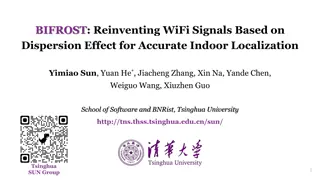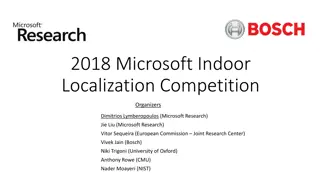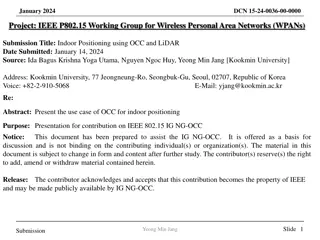Crowdsourcing-Based Indoor Localization Accuracy
This study delves into the accuracy of crowdsourcing-based indoor localization, exploring methods such as RF fingerprinting and modeling over calibration. It examines related infrastructure-based localization systems and steps like normalized auto-correlation-based step counting. The research also covers tracking with augmented particle filters and utilizing existing measurement databases for improved WiFi localization techniques in indoor environments.
Download Presentation

Please find below an Image/Link to download the presentation.
The content on the website is provided AS IS for your information and personal use only. It may not be sold, licensed, or shared on other websites without obtaining consent from the author.If you encounter any issues during the download, it is possible that the publisher has removed the file from their server.
You are allowed to download the files provided on this website for personal or commercial use, subject to the condition that they are used lawfully. All files are the property of their respective owners.
The content on the website is provided AS IS for your information and personal use only. It may not be sold, licensed, or shared on other websites without obtaining consent from the author.
E N D
Presentation Transcript
LOCALIZATION ACCURACY OF CROWDSOURCING BASED INDOOR LOCALIZATION CHENG WU 5110309335 Reference Zee: Zero-Effort Crowdsourcing for Indoor Localization
RELATED WORK Infrastructure-Based Localization Systems RF infrared RFID sniffers acoustic visual transmitters
RF FINGERPRINTING BASED LOCALIZATION accelerometer inertial sensors compass RF Fingerprinting WiFi or cellular signals gyroscope
Modeling instead of Calibration THE WHOLE STRUCTURE PICTURE
Modeling Steps 1.Placement Independent Motion Estimator (PIME). 2.Augmented Particle Filter(APF). 3.Creating the WiFi Database 4.WiFi-based initialization in APF. 5.Refinement of the WiFi database
COUNTING STEPS Typical mobile phone placement scenarios men{shirt pockets or rear pant pockets} women{in handbags and sometimes in pant pockets}
Normalized Auto-correlation based Step Counting (NASC).
Estimatimg heading offset range Magnetic Offset: Heading Offset: Placement Offset:
Tracking using augmented particle filter(APF ) stride length estimation
Put it all together : crowdsourcing Using existing measurement database for subsequent crowdsourcing. We can determine where in the floor a certain WiFi measurement was taken and generate location-annotated WiFi measurements of the form (location, WiFi RSS). This database of measurements can then be used to locate new users using existing WiFi localization techniques.
Performance of WiFi localization using crowdsourcing ERROR DISTRIBUTIONS
Q&A THANK YOU FOR LISTENING























